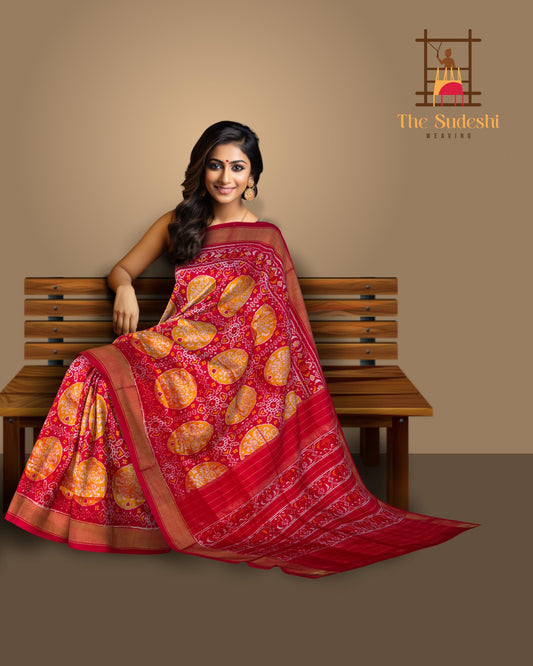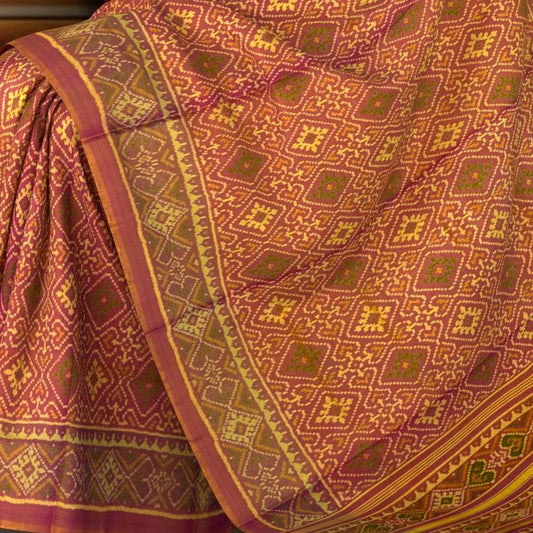Fusion of Tradition and Modernity: Latest Trends in Patola Sarees
Patola sarees, renowned for their intricate designs and vibrant colors, have long been a symbol of Gujarat's rich cultural heritage. These handwoven masterpieces, traditionally crafted in Patan, have transcended generations, maintaining their allure and elegance. However, as fashion evolves, so do these exquisite sarees. Today, Patola sarees are undergoing a fascinating transformation, blending traditional patterns with modern aesthetics, embracing new color palettes, and engaging in innovative design experiments. This fusion of the old and the new has resulted in Patola sarees that are not only timeless but also contemporary, appealing to modern sensibilities while preserving their traditional roots.
Contemporary Designs: The Fusion of Tradition and Modern Aesthetics
One of the most remarkable trends in Patola sarees is the seamless integration of traditional patterns with modern design elements. This fusion has given rise to sarees that resonate with both the heritage of Patola and the contemporary tastes of today's fashion-forward individuals.
1. Modern Motifs and Patterns: Traditionally, Patola sarees feature motifs such as elephants, parrots, flowers, and geometric patterns. While these motifs continue to be popular, modern designs have introduced abstract patterns, asymmetrical shapes, and minimalist elements. These contemporary motifs add a fresh perspective to the traditional designs, making them more versatile for various occasions.
2. Innovative Fabrics and Textures: In addition to design, the choice of fabric and texture has also evolved. While silk remains the fabric of choice for Patola sarees, designers are experimenting with different textures and finishes. Matte silks, silk-cotton blends, and even lightweight silks are being used to create sarees that are comfortable, versatile, and suitable for various climates.
New Color Palettes and Design Experiments
Color plays a crucial role in the appeal of Patola sarees. Traditionally, these sarees are known for their vibrant and bold colors, achieved through natural dyes. Today, while the essence of these colors remains, there is a noticeable shift towards new color palettes and innovative design experiments.
1. Pastels and Subdued Hues: Modern Patola sarees are embracing softer, pastel shades that offer a subtle yet elegant appeal. Colors like mint green, blush pink, and powder blue are being incorporated into the traditional palette, providing a contemporary twist to the classic designs. These subdued hues are perfect for daytime events and add a touch of modernity to the traditional attire.
2. Ombre and Gradient Effects: Another exciting trend is the use of ombre and gradient effects in Patola sarees. This technique involves blending two or more colors seamlessly, creating a beautiful transition from one shade to another. The result is a visually stunning saree that showcases a spectrum of colors, adding depth and dimension to the traditional patterns.
3. Metallic Accents: To enhance the grandeur of Patola sarees, designers are incorporating metallic accents such as gold and silver threads. These accents are woven into the fabric, adding a touch of sparkle and luxury. Metallic borders, motifs, and pallu designs are particularly popular, making the sarees suitable for festive occasions and weddings.
Collaborations with Contemporary Designers
One of the driving forces behind the modern adaptations and innovations in Patola sarees is the collaboration between traditional weavers and contemporary designers. These collaborations have resulted in sarees that are not only rooted in tradition but also reflect current fashion trends.
1. Designer Collections: Renowned fashion designers are now working closely with Patola weavers to create exclusive collections. These collections often feature a blend of traditional techniques and modern designs, catering to a wider audience. Designers bring their unique vision to the table, experimenting with colors, patterns, and styles while respecting the heritage of Patola weaving.
2. Limited Edition Sarees: Collaborations have also led to the creation of limited edition Patola sarees. These sarees are often part of special collections and are produced in limited quantities, making them highly coveted. Limited edition sarees may feature unique color combinations, intricate designs, or innovative weaving techniques, offering a fresh take on the traditional Patola.
3. Sustainable and Ethical Fashion: With a growing emphasis on sustainable and ethical fashion, collaborations between designers and weavers are focusing on eco-friendly practices. This includes using natural dyes, promoting fair trade, and ensuring the well-being of the artisans. Sustainable Patola sarees not only look beautiful but also align with the values of conscious consumers.
Embracing Modernity While Honoring Tradition
The journey of Patola sarees from traditional to modern is a testament to the versatility and timelessness of this art form. By embracing contemporary designs, experimenting with new color palettes, and collaborating with designers, Patola sarees continue to captivate fashion enthusiasts around the world.
1. Versatility for Various Occasions: Modern Patola sarees are designed to be versatile, suitable for a range of occasions from casual gatherings to grand celebrations. The fusion of traditional and modern elements ensures that these sarees can be styled in multiple ways, making them a valuable addition to any wardrobe.
2. A Global Appeal: As Patola sarees evolve, they are gaining recognition on the global fashion stage. Fashion shows, exhibitions, and international collaborations have brought these exquisite sarees to a wider audience. The unique blend of tradition and modernity resonates with people across cultures, making Patola sarees a symbol of India's rich textile heritage.
3. Preserving the Art of Patola Weaving: While modern adaptations are essential for keeping the tradition alive, it is equally important to preserve the art of Patola weaving. Efforts are being made to document traditional techniques, train new weavers, and provide platforms for artisans to showcase their work. This ensures that the legacy of Patola sarees continues for generations to come.
Conclusion
The evolution of Patola sarees is a beautiful example of how tradition can harmoniously coexist with modernity. By blending traditional patterns with contemporary designs, experimenting with new color palettes, and collaborating with modern designers, Patola sarees have become a symbol of timeless elegance and innovation. As we embrace these modern adaptations, we also honor the rich heritage of Patola weaving, ensuring that this exquisite art form continues to thrive in the ever-changing world of fashion.







Leave a comment
Please note, comments need to be approved before they are published.